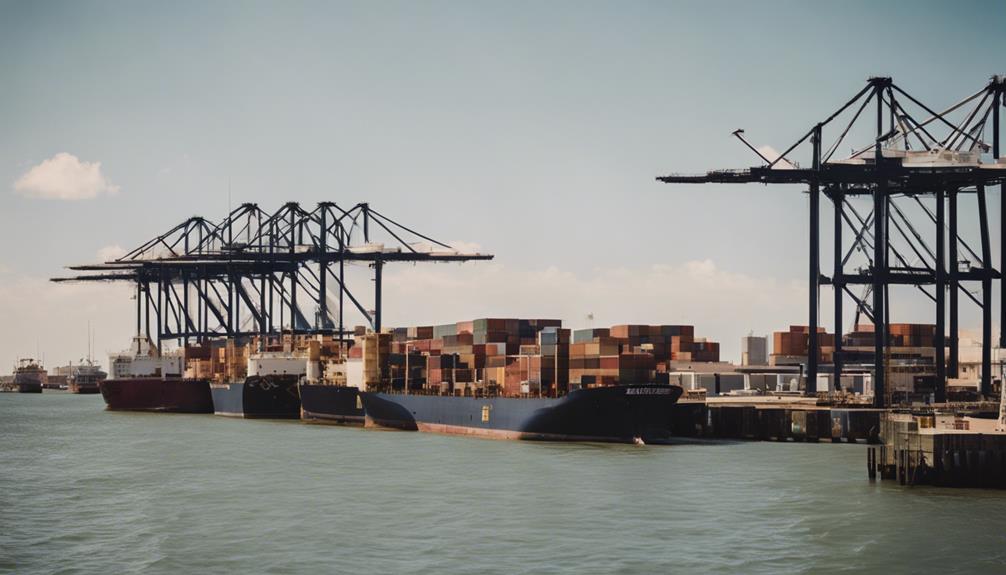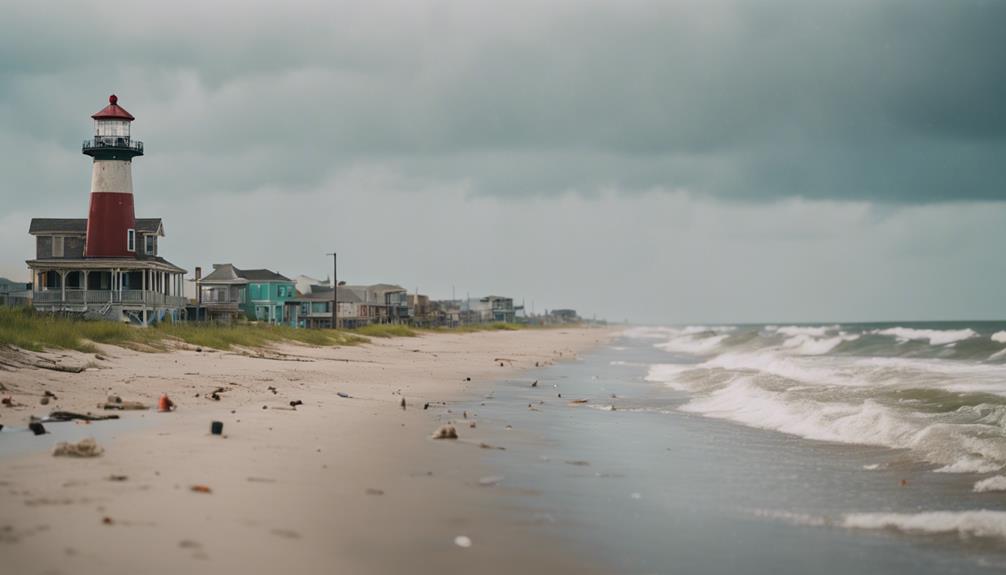Discover Galveston's storied past and Texas Gulf Coast's fascinating narrative. From early settlers like the Akokisa and Karankawa tribes to Spanish explorer Cabeza de Vaca, history grips this coastal region. Pirate Jean Lafitte's presence in 1817 ignited tales of buried treasures and adventurous exploits. The influx of immigrants shaped Galveston's cultural tapestry, making it a thriving business center. Its economic boom, marked by the title 'Wall Street of the South', influenced Texas' development. Juneteenth's historical significance in ending slavery resonates deeply in Galveston. The city's remarkable resilience against natural disasters only enhances its allure.
Key Takeaways
- Galveston's beaches offer sandy shores and warm Gulf waters for leisure and relaxation.
- The Texas Gulf Coast is known for its rich history, including early settlements, exploration, and pirate legends.
- Galveston's historical significance lies in its role as a major U.S. commercial center and immigration port.
- Juneteenth, marking the end of slavery, has deep roots in Galveston, emphasizing its Civil Rights importance.
- Natural disaster resilience post-1900 hurricane showcases Galveston's commitment to protection and development.
Early Settlement and Exploration
Explore the rich history of early settlement on Galveston Island and the Texas Gulf Coast. The island's first inhabitants were the Akokisa and Karankawa tribes, with Spanish explorer Cabeza de Vaca living among the Karankawa Indians in the 16th century.
In 1786, Galveston Island was named after Spanish governor Bernardo de Gálvez, marking its place in Texas history. The area saw further activity with the arrival of pirate Jean Lafitte in 1817, who established a colony on the island.
This period of early settlement and exploration laid the foundation for Galveston's importance in the region's history.
The interactions between the native tribes, Spanish explorers, and later figures like Bernardo de Gálvez and Jean Lafitte showcase the diverse influences that shaped the early days of Galveston Island. These events not only highlight the island's significance in Texas history but also set the stage for the intriguing tales of exploration and settlement that would follow.
Pirate Legends and Infamy

Pirate legends and infamy surround Galveston Island, particularly stemming from the infamous privateer Jean Lafitte.
Lafitte's establishment of the colony of Campeche in 1817 served as a strategic base for raiding Spanish merchant ships in the Gulf of Mexico.
The rumors of buried treasures left behind by Lafitte only add to the allure of Galveston's pirate lore.
Pirate Lore in Galveston
Amidst the rich history of Galveston's beaches and Texas Gulf Coast, tales of pirate lore and infamy bring a sense of mystery and adventure to the island's past. One of the most renowned figures in Galveston's pirate history is Jean Lafitte. Lafitte, a privateer, established the colony of Campeche on Galveston Island in 1817. From this base, he orchestrated daring raids on Spanish merchant ships in the Gulf of Mexico, earning a reputation for both cunning and brutality. Legend has it that Lafitte's plundered treasures may still be hidden somewhere on the island, adding to the intrigue surrounding his legacy. Galveston's association with pirate activity during Lafitte's time solidified its status as a hub of adventure and danger, attracting all manner of seafaring individuals seeking fortune and notoriety. The echoes of this pirate past still resonate through the sands of Galveston's beaches, reminding visitors of a time when the Gulf Coast was a hotspot for swashbuckling exploits.
| Pirate Activity | Jean Lafitte | Colony of Campeche |
|---|---|---|
| Raided merchant ships | Established colony | Base for operations |
Notorious Pirate Escapades
French corsair Jean Lafitte's daring exploits and illegal activities have solidified his reputation as a notorious figure in the history of Galveston's beaches and the Texas Gulf Coast. Lafitte, known for his role as a privateer turned pirate, established the Campeche colony on Galveston Island in 1817, using it as a strategic base for piracy and raiding Spanish merchant ships.
The tales of Lafitte's piracy and his elusive nature have contributed greatly to the island's notoriety as a hub for illicit maritime activities. Legend has it that Lafitte left behind buried treasures on Galveston Island, sparking ongoing rumors and treasure hunts that add to the mystique surrounding his pirate escapades.
Eventually, Lafitte fled the island, setting fire to the Campeche colony to avoid capture. This dramatic exit cemented Lafitte's legacy of mystery and intrigue in the region's maritime heritage, enriching Galveston's historical significance with tales of buried treasures and daring piracy exploits.
Immigration and Cultural Influence

As you explore Galveston's history, you'll find that the city's immigration patterns have had a significant impact on its cultural landscape.
The influx of diverse populations not only shaped Galveston's identity but also played an essential role in its development.
Understanding the historical significance of immigration in Galveston is important to appreciating the city's unique character.
Cultural Diversity Impact
The impact of cultural diversity stemming from immigration on Galveston's development is undeniable. The city's rich history reflects the influence of diverse immigrant groups, shaping Galveston into a flourishing business and industrial hub.
The cultural influences brought by immigrants have played a significant role in defining the city's growth and identity. Here are five key points highlighting the cultural diversity impact on Galveston:
- Immigrants contributed fundamentally to shaping Galveston locally, regionally, and nationally.
- The city's history of immigration propelled it to become the second largest immigration port in the U.S. after Ellis Island.
- Cultural influences from diverse immigrant groups helped establish Galveston as a thriving business center.
- Immigrant contributions transformed Galveston into a bustling industrial hub.
- The cultural diversity brought by immigrants has left a lasting imprint on Galveston's development and identity, enriching the city's fabric with a tapestry of different cultures.
Historical Immigration Patterns
Historical immigration patterns in Galveston reflect a dynamic interplay between cultural influence and economic development. The city's status as a prosperous port and its strategic location along trade routes made it a hub for diverse immigrants seeking new opportunities. The influx of immigrants significantly shaped Galveston's economic landscape, with many newcomers contributing to the flourishing business and industry sectors. This diverse immigrant population not only bolstered the city's economy but also played a crucial role in enriching its cultural fabric and historical development.
| Historical Immigration Patterns | Impact on Galveston |
|---|---|
| Prosperous Port | Attracted diverse cultural influences |
| Trade Routes | Connected Galveston to global migration flows |
| Economic Landscape | Shaped by immigrant contributions to business and industry |
| Cultural Richness | Enriched by the diversity of the immigrant population |
| Historical Development | Immigrants played a significant role in shaping Galveston's history |
Economic Hub and Trading Center

At the heart of Galveston's rise to prominence lay its bustling economic activity and pivotal role as a trading hub in the Texas Gulf Coast region.
Galveston became a major U.S. commercial center due to its natural deep-water port and strategic trade routes. It welcomed hundreds of thousands of immigrants who settled locally, moved regionally, and played a fundamental role in state and regional growth.
By 1885, Galveston was the largest and richest city in Texas, serving as the second largest immigration port after Ellis Island. The city flourished in business and industry, establishing itself as the 'Wall Street of the South' with a booming economy.
Galveston's economic prosperity and trading activities made it a key player in the development of Texas and the Gulf Coast region.
Juneteenth and Civil Rights Significance

Galveston's pivotal role in economic growth seamlessly intertwines with its profound significance in Civil Rights history, particularly through the celebration of Juneteenth.
Juneteenth commemorates the end of slavery in Galveston in 1865 when General Granger issued General Order No. 3, freeing over 250,000 enslaved Black people and marking the celebration of Emancipation. This event holds immense historical significance as it symbolizes the liberation of the last group of slaves in the United States.
Galveston's Juneteenth stands as a pivotal moment in Civil Rights history, highlighting the city's vital role in ending slavery and advancing the rights of all individuals. The celebration of Juneteenth in Galveston not only honors the struggles and triumphs of the past but also serves as a reminder of the ongoing fight for equality and justice.
Its legacy continues to resonate across the Texas Gulf Coast, inspiring generations to uphold the principles of freedom and civil rights.
Natural Disaster and Resilience

Following the deadliest natural disaster in U.S. history, Galveston demonstrated remarkable resilience in response to the 1900 hurricane. The city's actions post-tragedy shaped its future, emphasizing the importance of preparedness and adaptation in the face of environmental vulnerabilities like hurricanes.
Here are some key points to ponder:
- The 1900 Galveston hurricane claimed over 6,000 lives, prompting the city to elevate most of the island by 17 feet to create the Seawall Boulevard for enhanced storm protection.
- The Seawall now stands as a 17-foot high protective barrier, symbolizing Galveston's commitment to mitigating the impact of future hurricanes.
- Galveston's rebuilding efforts post-1900 hurricane not only focused on infrastructure but also revitalized the city, transforming it into a popular tourist destination.
- The city's ability to evolve and maintain its historic charm while addressing environmental vulnerabilities showcases its resilience in the face of natural disasters like hurricanes.
Frequently Asked Questions
Why Is Galveston Important to Texas History?
Galveston holds significance in Texas history due to its pivotal role as a major port of entry for European immigrants in the mid-1800s and as the primary port during the Texas Revolution.
By the late 1800s, it became the state's largest city, showcasing economic prowess. The discovery of oil further boosted its economy, solidifying its place in Texas history.
The enduring importance of the Port of Galveston highlights its significant role in shaping the state's historical narrative.
What Is the History of Galveston Bay?
Galveston Bay's history is a tapestry of maritime significance. With Spanish origins, the bay's deep-water harbor lured immigrants and traders, shaping Galveston's rise as a pivotal port.
This strategic location catalyzed economic growth and exploration in the region. The bay's legacy intertwines with Galveston's development, anchoring its importance in Texas history.
Explore further to uncover the layers of historical richness that have made Galveston Bay a cornerstone of the Texas Gulf Coast.
How Was Galveston Beach Formed?
Galveston Beach formed as a barrier beach on the Texas Gulf Coast. Initially, natural protection from hurricanes existed through sand dunes. However, development activities led to the removal of these dunes, leaving the area vulnerable to storms.
The beach's creation is intertwined with the island's history and its strategic geographical position along the Gulf Coast. Human intervention and natural forces have greatly influenced the evolution of Galveston Beach and its coastal landscape.
What Was Galveston Known for Before the Hurricane?
Before the hurricane, Galveston was renowned for its natural deep-water port, bustling commercial activity, and significant role as a major U.S. commercial center. It attracted hundreds of thousands of immigrants, fostering growth and prosperity, earning it the moniker 'Wall Street of the South.'
The city served as the second largest immigration port in the country, after Ellis Island, drawing a diverse population. Additionally, Galveston made history as the birthplace of Juneteenth in 1865, marking the end of slavery.
Conclusion
To sum up, Galveston's beaches and Texas Gulf Coast history are rich in tales of exploration, piracy, culture, trade, and resilience. Just as the waves of the Gulf ebb and flow, so too has the history of this coastal region evolved over time.
Like a lighthouse guiding ships through stormy waters, the stories of Galveston's past illuminate the path forward, reminding us of the strength and endurance of those who've called this place home.










